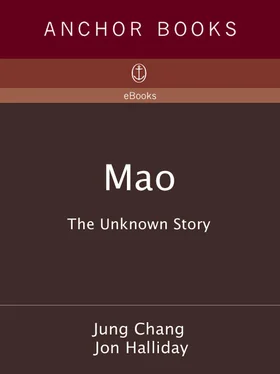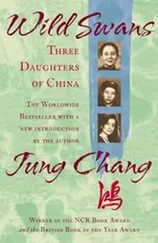A week later, on 25 June, Kuo-tao, having ridden over three days through virgin forests and rocky gorges, arrived to meet Mao and his companions at a village called Fubian. The two biggest Red armies were now formally linked up.
DAYS LATER, on 4 July, Chiang Kai-shek’s brother-in-law, H. H. Kung (vice-premier and finance minister), called on Soviet ambassador Dmitri Bogomolov, ostensibly to discuss Japan’s moves in northern China. At the very end, Kung remarked that the Generalissimo very much wanted to see his son. This was Chiang saying to Stalin: I have allowed two major Red armies to survive and join forces, would you please let me have my son? “We are not putting any obstacles in the way of him leaving,” Bogomolov replied, lying smoothly, “but as far as I know, he does not want to go anywhere.”
Although he did not get his son back now, Chiang had achieved his goal of bringing the three southwestern provinces under the central government. The Guizhou warlord had been forced to resign, and left the province after being lavishly bought off. The Yunnan governor stayed on and maintained a good relationship with Chiang (for the time being). With his own army now in Sichuan, following at Mao’s heels, Chiang returned there in May to assume control of this strategically important — and most populous — province. Here he spent months of intensive activity to build up Sichuan as his base for war against Japan.
Mao too had succeeded in his goal. The 2,000-kilometer detour he had forced upon the Red Army had bought the time to establish his puppet Lo Fu as de facto Party chief, and Mao had secured his grip on the Party leadership as the man behind the throne. Chang Kuo-tao’s chances had been critically reduced. Mao’s machinations had reduced the ranks under him by tens of thousands, to around 10,000 hungry and exhausted men in rags. But no matter to him. The army could be rebuilt.
As always, Mao regarded the Kremlin as his only hope if he was to conquer China. Now that he was nearer than ever to Russian-controlled territory, he began to talk about requesting “matériel and technical assistance” from Soviet Central Asia. His paramount aim now was to ensure that Chang Kuo-tao, who outgunned him by about 8 to 1, did not gain access to Soviet arms — or the Kremlin’s ear — before he did.
Lack of majority support for Mao is also clear from the fact that when he later referred to those who had supported him at Zunyi, he never produced more than two names — those of his two co-conspirators.
Soviet military attaché Lepin secretly advised on the best supply routes. The former CCP leader Li Li-san was sent from Moscow to a secret GRU base on the Chinese border, to try to establish radio contact. The US vice-consul in Yunnan, Arthur Ringwalt, spotted the danger, and warned Washington in early January 1935: “The situation appears to be increasingly serious for China. Unless a miracle happens, the Communists will force an entry into Szechwan [Sichuan] by one route or another. [Then] it will be only a matter of time before the well-known plan … to establish communications with Soviet Russia will have been carried out. Then it will be useless to talk further about communist suppression.”
Another person who made the point was, surprisingly, a very important British spy for Russia, Kim Philby. In an article about Tibet published in Nazi Germany in 1936, Philby emphasized the strategic significance of the Chinese Reds linking up with the Russians in the northwest.
Chang Kuo-tao was so successful mainly because the part of Sichuan he entered was in the grip of some exceptionally heartless warlords who squeezed the population so hard that even in towns there were many people who could not afford clothing, and were walking round completely naked. There had been several peasant uprisings just before Kuo-tao’s army arrived, and his forces had been able to enlist recruits en masse. He also had a military chief, Xu Xiang-qian, who was arguably the most talented of the Chinese Communist commanders.
Normal procedure on the March was to leave the wounded with local families, with some money. The fate of those left behind was a matter of luck. Chang Kuo-tao’s branch left behind some women soldiers who were too ill and weak to go on. When Party historians went looking for them half a century later, they found they had endured atrocious experiences. The locals, whose families had suffered at the hands of the Reds, took it out on them, and tortured some of the women to death by driving wooden stakes into their vaginas and cutting off their breasts. To survive, some women married more affluent peasants. But when their own Party came to power they were designated as “landlords,” and denounced, humiliated and discriminated against for life. In 1985, in bitter November cold, the few seen by Party historians, by then in their sixties and seventies, were so poor that they did not wear shoes to the encounter, as these were considered too valuable to endanger for such a non-essential occasion.
Chiang and his officers were so mystified that they thought Mao wanted to attack the capital of Guizhou, where Chiang was, to try to get Chiang himself. But the Reds sped past without stopping.
†In Guizhou, where the population was dirt-poor, the Reds had recruited many thousands of young men.
Giving birth on the March was a nightmare. One woman who had gone into labor had to walk to the night’s destination with the baby’s head dangling out. Next day before dawn, weeping at leaving her baby in a bundle of straw in the empty hut, she had to walk on, and fainted wading through an icy river. Her women comrades found a table to carry her on. The wife of Teng Fa, the then head of the Chinese KGB, had a most painful delivery. Writhing in agony, she cursed her husband for making her pregnant. Teng Fa was fetched, and stood uncomfortably in the little hut, hanging his head. Mrs. Po Ku would say half jokingly: “On the march, I prefer a donkey or a horse to an old Male!”
A picture of it features on the cover of the 1985 book The Long March , by Harrison Salisbury, which purveys the official post-Mao version.
Nationalist plans on the 28th described the task of the unit, under Yu Song-lin, as “to defend Kangding,” a city about 50 km away as the crow flies. The fact that Yu’s troops were not at or near the bridge is demonstrated in a report of 3 June by the governor of the region.
When Peng De-huai, the most honest of all the Communist leaders, was asked about the Dadu crossing by a British writer in 1946, he gently, but very clearly, refused to endorse the myth. “It’s a long time ago, and I cannot remember all of it. There were so many rivers — the Gold Sand river, the Hsiang river, the Wu and the Yangtse … I cannot remember very much, but I remember the people falling into the water …” He did not say one word about fighting, or a burning bridge. It seems that two or three people did die at the bridge, but only when they fell off while repairing it, when one old plank suddenly snapped, as Mrs. Zhu De and the 93-year-old local we interviewed remembered. For good measure, the Reds constructed an ancillary myth about more heroism around the other crossing of the Dadu River, at Anshunchang, some 75 km to the south. Although this ferry crossing was extremely exposed and it took the troops a whole week to cross, with spotter planes circling overhead, there was not a single battle casualty here, either.
14. LONG MARCH III: MONOPOLIZING THE MOSCOW CONNECTION (1935 AGE 41)
WHEN THE TWO Red armies joined up in June 1935, Mao’s force — known as the Central Red Army, as it came directly under the Party leadership — was in a state of ruin. It had started the Long March with 80,000 men. Now it was down to some 10,000—one-eighth its original strength. The surviving remnant was on the verge of collapse. It had lost nearly all its heavy weapons, and its rifles had an average of only five bullets each. As Zhu De lamented to Chang Kuo-tao, who was an old friend, this army “had been a giant before, but now it’s only a skeleton. It can no longer fight.”
Читать дальше










